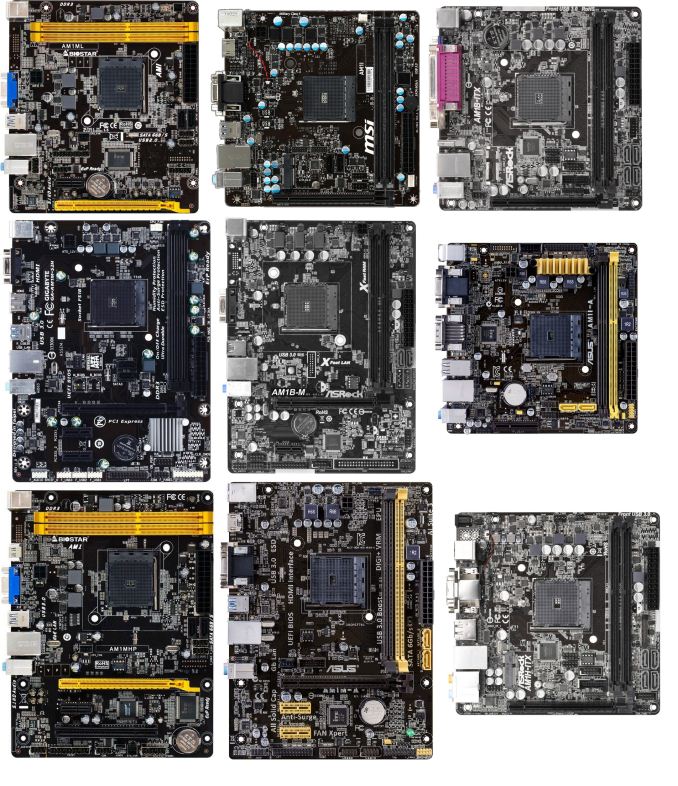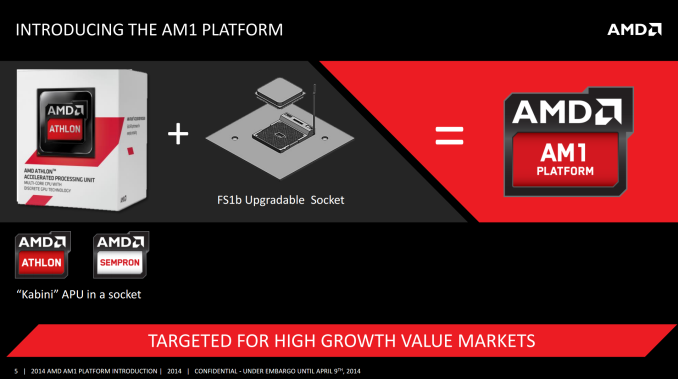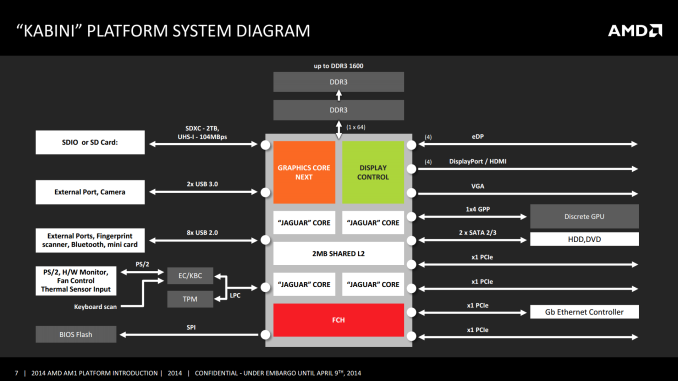The AM1 Kabini Motherboard Preview: Analyzing the Hardware
by Ian Cutress on April 19, 2014 2:00 PM EST
One of AMD’s primary feature points for the AM1 Kabini platform was the introduction of low-cost motherboards. The promotional material provided gave a suggested AM1 combined price of $60. Now after release the cheapest APUs are $31 for a dual core and $35 for a quad core. This should mean motherboards from $29 and up. Today we take a brief preview of nine motherboards currently on sale, which start at $33.
The AM1 Ecosystem
Almost every end-user I converse with prefers naming consistency in technology products. There has to be a clear progression in naming structure showing the development of a platform over time and generations. There have been plenty of examples – AMD’s enthusiast chipset (580/690/790/890/990FX), both AMD and NVIDIA’s GPU lines, Intel’s chipsets (P35, X48, P55, P67, Z77, Z87). The issue arises when the naming scheme is non-contiguous. The naming of AMD’s three main processor and chipset lines are as follows:
The top end features the AM3+ socket, which came from AM3, AM2+ and AM2. The mid-range is the FM2+ socket, deriving from FM2 and FM1. The low-price segment is now being called the ‘AM1 platform’. It makes it sound like it should be a very old version of AM3, because at least colloquially it will just be called AM1. In reality, that word ‘platform’ is the kicker here, because the socket is actually called FS1b:
What makes it called the AM1 platform is the use of a Kabini APU in an FS1b upgradable socket. That does not help that all the motherboards on sale will be given the AM1 designation. This means that if the next iteration of the Athlon processors using ‘Puma’ cores (codename “Beema”) comes along and they call it the ‘AM2 platform’ (insert more confusion with the AM2 socket), it might still be the FS1b socket in the middle of the motherboard.
Naming conventions aside, because Kabini processors are system-on-chips rather than platforms with a discrete south bridge, all the IO is determined on die. AMD is at least keeping the core of the IO the same across all the Kabini APUs:
The key points to note here are:
- Single Channel 64-bit DDR3/DDR3L
- Two USB 3.0
- Eight USB 2.0
- PS/2
- Trusted Platform Module Support
- Up to four eDP/DP/HDMI video outputs
- VGA output
- Four PCIe 2.0 lanes for a discrete GPU/PCIe device
- Two SATA 3 Gbps ports
- One PCIe 2.0 x1 lane allocated to an Ethernet controller
- Three PCIe 2.0 x1 lanes for other controllers (SATA, USB, LAN, WiFi, PCIe 2.0 x1 slots, PCIe to PCI bridges)
As we go through the following motherboards, we will see that some manufacturers use USB 3.0 or SATA 6 Gbps controllers, powered by the PCIe 2.0 x1 lanes, in order to bump up the functionality. There is scope for development in the networking and audio solutions as well.













64 Comments
View All Comments
coolhardware - Saturday, April 19, 2014 - link
Nice brief overview of the motherboards, wish there was some more meat to the article. I guess that comes later!I have the MSI AM1I with an Athlon 5350 and have been loving it. The MSI can actually do a slight CPU OC by setting the multiplier to 21x which gets the clock to 2.1GHz (as opposed to 2.05GHz stock) and it overclocked my 1333 memory to 1666 with no problem. Overall it's a sweet little board for the price!
Anybody else with other AM1 motherboards notice any OCing options?
I'm posting my experiences here: http://www.jdhodges.com/blog/amd-kabini-athlon-535...
Also, I want to find out if it can drive three displays (DVI+VGA+HDMI) and looking forward to trying some high-res output from the HDMI port. I doubt the DVI is dual link, but I plan to find out for sure by trying my trusty Dell 30" 2560x1600 display :-)
meacupla - Saturday, April 19, 2014 - link
does SODIMM DDR3L cost more to implement than desktop DDR3?All of these boards could have saved a ton of space by going with SODIMM, but none have.
Why?
MonkeyPaw - Saturday, April 19, 2014 - link
With the SOC taking on most of the work, the boards don't need to worry about space savings, as they still need to fit in the standard ITX/ATX form factors. I imagine the legacy DIMM slots are cheaper anyway. These boards are engineered for cheap, which is why you see 10/100, 2.1 audio, USB 2.0, or limited expansion options. If a better option was even 5 cents more, they probably skipped it. I'm surprised these things aren't white boxed!Voldenuit - Sunday, April 20, 2014 - link
Ian: is the Biostar mini-DTX (23x17 cm) instead of mini-ITX? I haven't heard of mini-ITX plus before.Voldenuit - Sunday, April 20, 2014 - link
Typo: Mini-DTX is 20.3x17cmElFenix - Monday, April 21, 2014 - link
the board is 19.1x17, so it fits within the mini-DTX size specification. however, biostar calls it micro atx on its website.geniekid - Tuesday, April 22, 2014 - link
It is mini-DTX, but I guess it shows how unpopular the spec is given that even an AT writer came up with his own term for it.IMO there's a lot of potential for mDTX for people who want compact systems without giving up a graphics card or their audio card.
yannigr - Sunday, April 20, 2014 - link
I hope there is an overclocking part coming in the future. I have seen a 5150 running at 2.1GHz(ASUS board). On the other hand at Phoronix they hit the wall at 105MHz bus for some reason.An article about overclocking, especially the Sempron, would have been great. There is a possibility that Sempron to be the second product from AMD that I will buy and will have a 3850 as a model number. I am just waiting for more info from around the net.
PS If kabinis where black edition chips AMD wouldn't be able to produce them fast enough.
coolhardware - Sunday, April 20, 2014 - link
MSI can run the 5150 at 2.1GHz as well, screenshots here:http://www.jdhodges.com/blog/amd-kabini-athlon-535...
Anybody seen more than 21x on a 5150? And do the lower end Kabini's overclock any?
yannigr - Monday, April 21, 2014 - link
It is NOT the 5150 in the test but the 5350. Look the link itself. It says 5350.MSI only seems to have the option to change the multiplier, not the bus speed. And the multiplier will give you extra 50MHz IF the APU has a multiplier with a .5 in it, like 5350 it has 20.5 multiplier. So you can change it to 21. If this was a 5150 with 16 multiplier you wouldn't be able to go any higher than that. Not a single MHz.
Thanks for the link anyway!